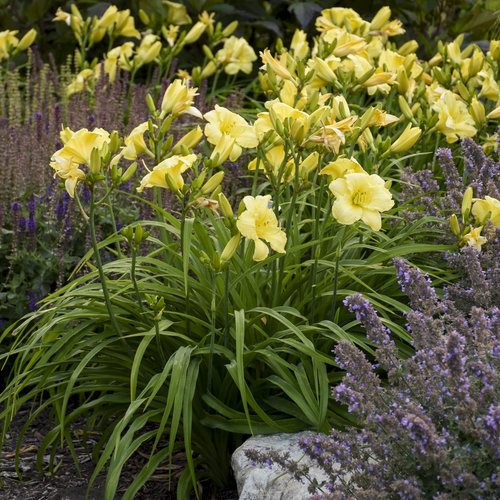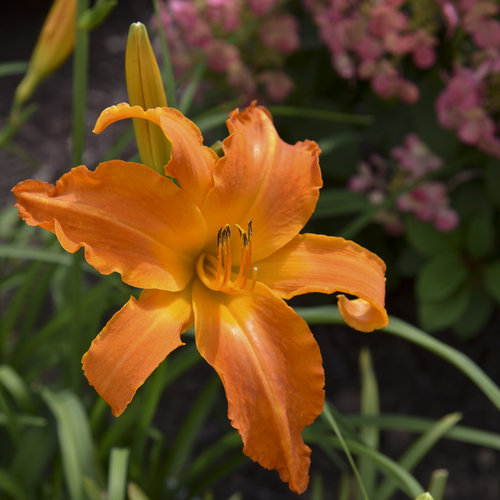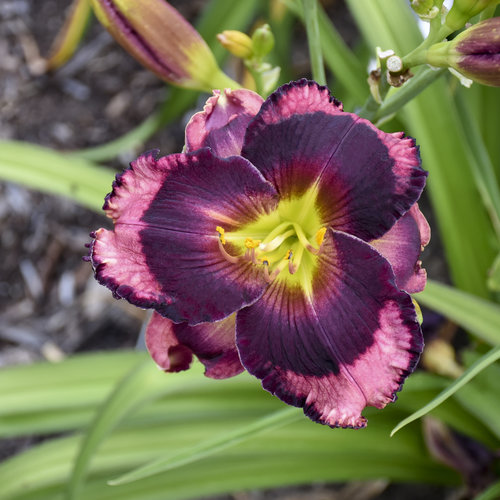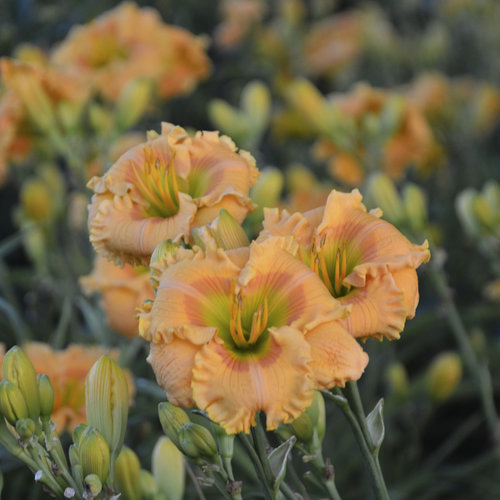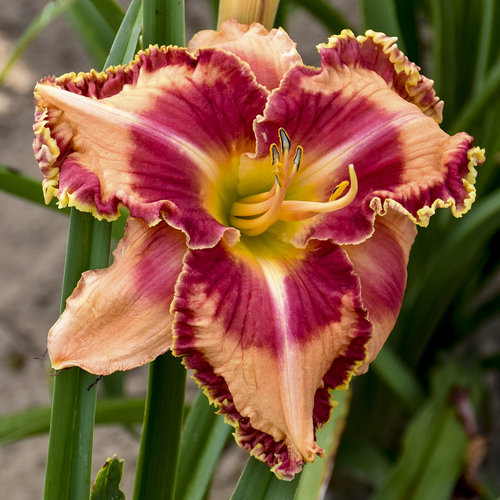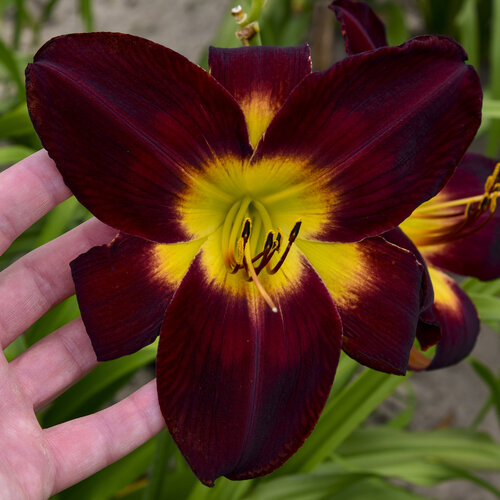Daylily - The Ultimate Growing Guide from Proven Winners®
Grow this popular flowering perennial for dazzling summer-long color
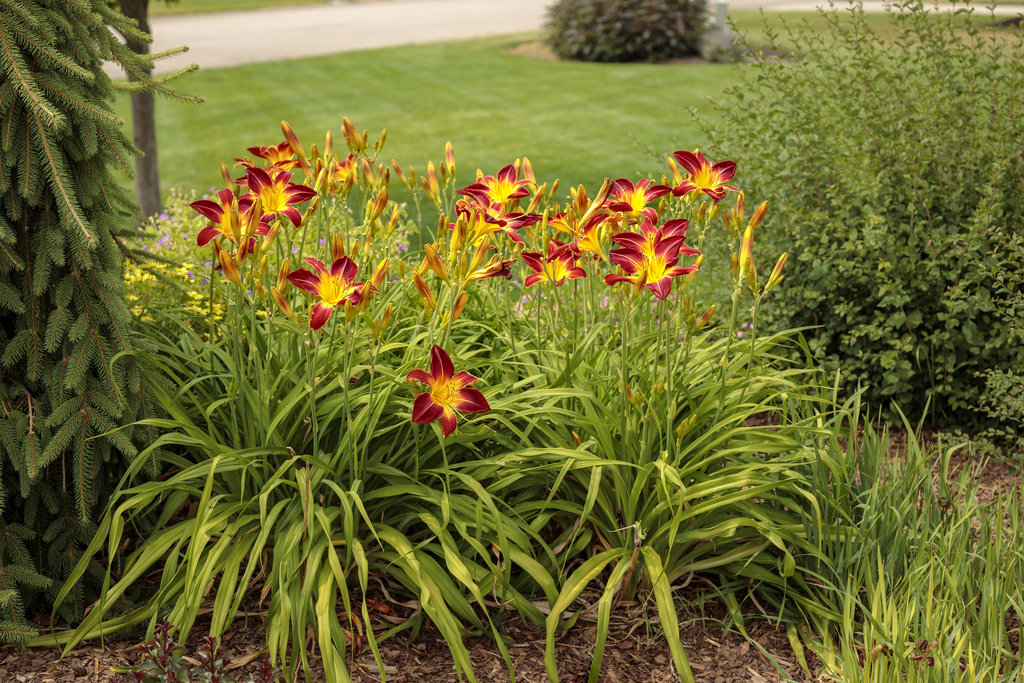 Buy daylily plants - Order online and have them shipped right to your door
Buy daylily plants - Order online and have them shipped right to your door
Daylily (Hemerocallis spp. and hybrids) is one of the most popular garden plants to grow, and for good reason. This reliable flowering perennial produces elegant grass-like foliage and showy trumpet-shaped blooms in a range of colors, sizes and forms. Daylily colors occur in nearly every hue except for true white and blue, with long flower stems that can reach up to 5-feet tall.
The individual flowers of daylilies bloom for just a single day—hence the common name—but the leafless stems, known as scapes, produce multiple blooms on each stem over several weeks. This long-lived herbaceous perennial grows in most regions, remaining semi-evergreen in milder climates. Daylily needs minimal care once established, making it a good choice for low-maintenance borders, beds and containers. Here’s how to grow and use them in your landscape.
DAYLILY CARE & PLANTING
How to plant: Daylilies grow in clumps that are comprised of fibrous tuber-like roots. Plants are available as container grown or bare root daylily bulbs. When planting daylilies, choose a site with full sun and rich, well-drained soil. Follow these steps and space plants 1-1/2 to 3-feet apart.
- Loosen soil in the planting area and amend with compost or other rich organic matter to add nutrients and improve drainage.
- Remove the daylily clump from its nursery container and tease out the roots if potbound. If planting bare root specimens, make sure they are clean and free of pests or damage.
- When digging a hole, make it slightly wider and deeper than the root ball. Set the plant in the hole so the top of the root ball is level with the surrounding soil. Avoid planting too deep.
- Backfill the hole with soil, tamp down lightly to remove air pockets, and water well.
- Keep plants watered regularly until established.
Soil: Daylily is tolerant of different soils and pH levels, but prefers rich, well-draining soil. For containers, use a high-quality all-purpose potting mix.
Watering: Daylilies perform best with consistent moisture. Provide regular water, especially when plants are developing new foliage and flower buds. Plants may become somewhat drought tolerant once established. Avoid overhead watering when plants are blooming to prevent damage to the flowers.
Fertilizing: When planted in well-amended soil, daylilies need little or no supplemental fertilizer. To boost performance, use a slow-release granular 10-10-10 fertilizer in early spring according to instructions. Apply fertilizer around the base of plants. Spread a thin layer of organic mulch around plants to add nutrients, suppress weeds and retain moisture.
How to deadhead a daylily: Removing spent flowers regularly is key to extending bloom time. This puts energy into forming new flowers rather than seeds. When removing spent blooms, pinch the base of the daylily flower between your thumb and forefinger and gently snap it off. Make sure to remove the seeds (ovaries) that form just below the petals. Take care not to damage or remove adjacent flower buds.
Find more on why and when to deadhead flowering plants.
TRY THESE PROVEN WINNERS® VARIETIES
Add these beautiful daylily varieties to your yard:
Zones: 3-9 Find more yellow flowers for your garden |
Zones: 3-9 |
Zones: 3-9 |
Zones: 3-9 |
Zones: 3-9 |
Zones: 3-9 |
DAYLILY FAQ’s
Do daylilies prefer sun or shade?
Daylilies need at least 6 hours of direct sun each day. Plants can tolerate light shade, but will bloom best in full sun.
How do you keep daylilies blooming all summer?
To extend bloom time, deadhead spent flowers regularly to promote the formation of new buds. Reblooming varieties will flower longer than other types. Daylilies not blooming can result from too little light, poor soil, overcrowding, or from clumps being planted too deeply.
What is the best place to plant daylilies?
Choose a sunny site with rich, well-draining soil. Provide some afternoon shade in hotter climates.
Do daylilies come back every year?
Daylily plants are reliable hardy perennials that will survive for many years. Divide daylily clumps every few years to extend longevity.
When do daylilies bloom?
Daylilies begin blooming as soon as early spring in southern climates, with flowers occurring from late spring to summer in cooler regions. Reblooming varieties can flower into fall.
Do deer eat daylilies?
Deer will graze on daylily foliage, particularly new spring growth. They may also nibble on flowers. However, these plants are resilient to deer browse and should recover. If you live in a deer-prone area, use protection or repellent.
Do daylilies spread?
Daylilies form dense root clumps that will expand as plants mature. Clumps should be divided every few years for the best flowering.
When to divide daylilies?
Divide daylily clumps in early spring as new growth is emerging, or after plants have finished flowering in late summer. Pull the dense, fleshy clumps apart, or use a sharp knife to cut the root system into pieces. Replant divisions in newly amended soil.
When to plant daylilies?
Daylilies can be planted in spring or fall during cooler months to prevent shock from extreme heat or cold. Potted plants are generally sold in spring and summer, while bare root plants are available in early spring and early fall.
When to cut back daylilies?
When pruning daylilies, remove dead foliage back to the base of plants in early spring before new growth appears. It is normal for foliage to partially turn brown or yellow as the growing season progresses. Remove unsightly foliage as it occurs. Cut spent flower stalks and seed pods back to the base of plants when they are finished blooming for a tidier appearance, and to put energy into new foliage and flower production.
How long do daylilies bloom?
Individual flowers last for one day, though dozens of flowers are produced on each plant. If regularly deadheaded and properly cared for, daylilies can bloom for several weeks or more.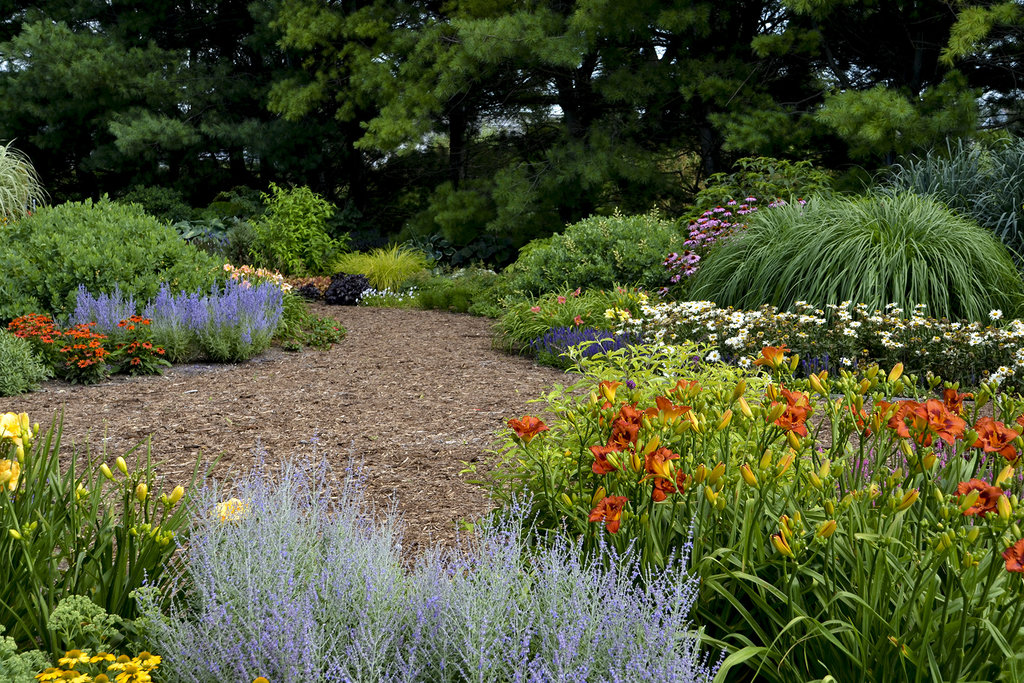
LANDSCAPING IDEAS WITH DAYLILIES
There are many ways to use daylilies in your landscape. Here are some ideas:
- Mass daylilies with similar or complementary colored flowers along a slope for a showy display, and to help stem erosion.
- Smaller varieties can be planted in a container by themselves, or in combination with other plants with similar growing needs.
- Plant a row of daylilies in a sunny spot along your home’s foundation.
- Hostas and daylilies make good companion plants, producing complementary colors, shapes and textures. Plant a variety of hosta plants next to your favorite daylilies in a bed or border that receives ample morning sun and some afternoon shade for a stunning season-long display. Find more companion plants for hostas.
- Showcase your favorite daylily plant variety in a decorative container and display on a deck or patio where you can enjoy the beautiful blooms up close.
- Include daylilies with different flower colors and heights in a mixed border in combination with other perennials, shrubs and trees that bloom at different times for compelling season-long color.
- Adorn a curbside strip or area along a fence line with a row of daylilies.
- Include daylilies in a cottage-style border alongside shrub roses, bee balm, phlox, delphinium, foxglove and lavender for an exuberant display.
- Use dwarf varieties to edge a border or pathway.
- Plant in a rock garden alongside other plants with similar growing needs.
- Adorn the edge of a pond or stream with colorful daylily varieties.
DAYLILY COMPANION PLANTS
Plant daylilies alongside other plants with similar cultural needs of full sun to partial sun and rich, well-draining soil.
To create a low-maintenance border, combine daylilies with other easy-care plants such as:
- Blue Chiffon® rose of Sharon
- ‘Denim ‘n Lace’ Russian sage
- Prairie Winds® ‘Cheyenne Sky’ red switch grass
- Sweet Emotion® abelia
Find more of the best low-maintenance plants.
For weeks of continuous color, plant daylilies alongside other long-blooming plants such as:
Find more long-blooming shrubs and perennials.
For a colorful summer-blooming perennial border, plants daylilies with:
- Amazing Daisies® Daisy May® Shasta daisy
- ‘Pardon My Rose’ bee balm
- Summersong™ Firefinch™ coneflower
- Sweet Romance® lavender
Buy Proven Winners plants:



